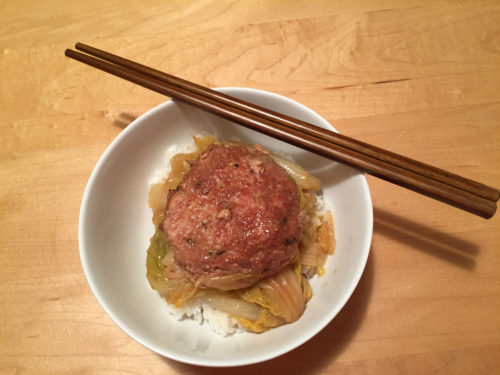
2021 CNY banner with young Asian family making greeting gestures in octagonal window frame. Concept of visiting friends. Translation: Happy Chinese new year
Happy Lunar New Year! It has been a very long time since I posted — what better time to make a fresh start than Lunar New Year?
In my book The Nian Monster, it’s the aroma of Po Po’s pork and cabbage casserole that lures the terrible beast to Xingling’s apartment. Chinese dishes often have fanciful or poetic names and this one is no different. It’s called Shi Zi Tou (獅子頭), which translates literally into Lion’s Head, and is a popular dish in Shanghai. The large pork meatballs surrounded by the ruffled cabbage leaves are said to resemble the head and mane of a lion. I think someone had a little too much mijiu (rice wine) when they came up with that name, but the dish itself is warm and savory and perfect for cold nights and, of course, Lunar New Year.
Here’s the recipe I use, from Huang Su-Huei’s wonderful cookbook, Chinese Cuisine.* My mother-in-law gave the cookbook to my husband when he left Jakarta to attend college half a world away (and several decades ago). We just found a used copy online and gave it to our college-aged son, keeping up the tradition.
Lion’s Head Casserole
3.3 lbs napa cabbage
1 lb ground pork
Mixture #1
3/4 tsp rice wine
3/4 tsp salt
dash of sesame oil
dash of ground black pepper
1 tsp chopped scallions (green onions)
1 tsp minced ginger root (you can sometimes also find ginger puree in a tube in Western grocery stores, in the fresh herbs section)
1 egg
4 Tbsp water
1/2 Tbsp cornstarch
Mixture #2
1/2 Tbsp soy sauce
1/2 Tbsp water (cold or room temperature. If you use hot water, the cornstarch won’t dissolve.)
1/2 Tbsp cornstarch
Mixture #3
1 Tbsp soy sauce
1/2 tsp salt
Directions:
Rinse the cabbage lightly; remove and retain four of the large outer leaves (keep them whole). Chop remaining cabbage leaves into 2-inch pieces.
Mix the ground pork with Mixture #1, then divide into four portions. Roll each portion into a ball. (Four is an unlucky number in Chinese culture, so I usually make five smaller meatballs.)
Stir Mixture #2 together in a shallow bowl or plate until cornstarch is dissolved.
Heat wok then add 4 Tbsp oil. Dip each meatball into Mixture #2 (you have to kind of roll it around so it is evenly coated. Yes, it’s messy). Fry the meatballs until all sides are golden brown; remove. (Don’t worry if the meatballs flatten out a bit — real lion’s heads aren’t perfectly round, either.)
Fry the pieces of cabbage (in the same wok) and add 1 cup water; cover and cook for 5 minutes or until soft. Line the bottom of a large pot (like a Dutch oven) with the cabbage. Place the meatballs on top of the cabbage. Cover the meatballs with the four cabbage leaves reserved in the first step (these are the “manes!”). Add Mixture #3; cover and turn the heat to low.
Cook for 1 hour or until cabbage is soft. Serve with steamed rice.
My Notes:
The recipe says that pressed bean curd, Chinese black mushrooms (dried winter mushrooms or shiitake mushrooms that have been rehydrated), and bamboo shoots may be added to the ground pork to taste. Chop finely before adding.
Supposedly, this recipe serves 12. But if you have ravenous teens (AKA your very own Nian monsters) like I do, you can increase the amount of ground pork and Mixture #1 accordingly and just make more meatballs.
I don’t think this dish technically qualifies as a casserole since it’s made on the stovetop and not the oven, but, you know, it sounds better. I also use a pressure cooker to reduce the cooking time (see aforementioned ravenous teens). I haven’t tried it, but I bet you could adapt this recipe for a slow cooker or Instant Pot, too.
Enjoy!

Large pork meatball on bed of cabbage and rice in a white bowl with chopsticks resting across it.
*: Huang Su-Huei. Chinese Cuisine. Wei-Chuan’s Cooking, Taiwan and California. 1984.



